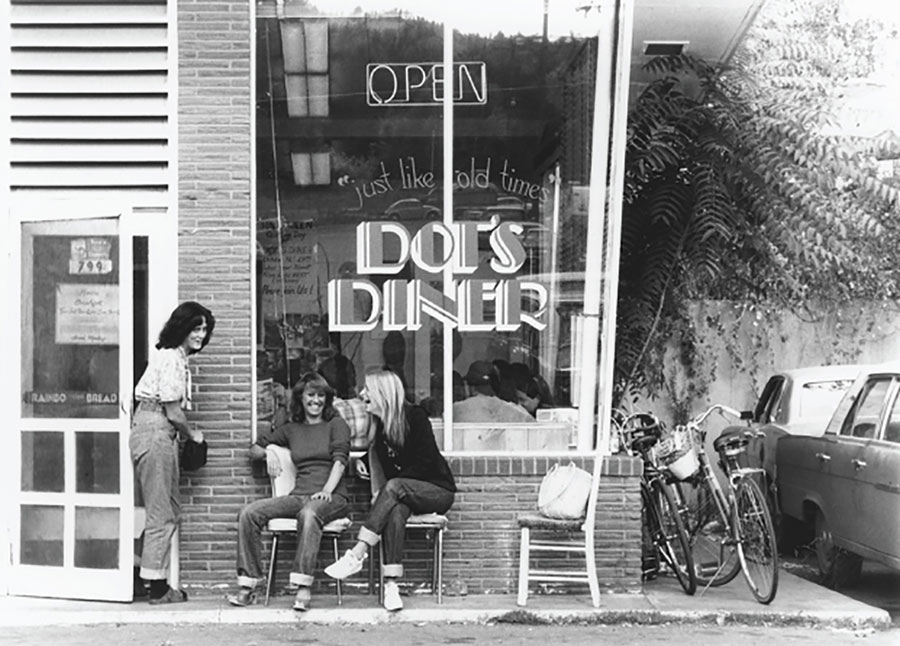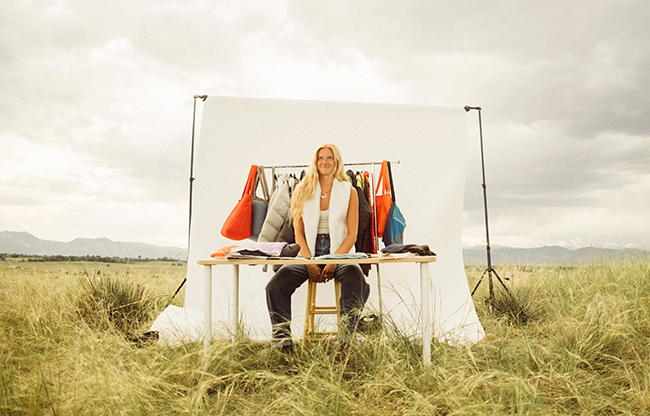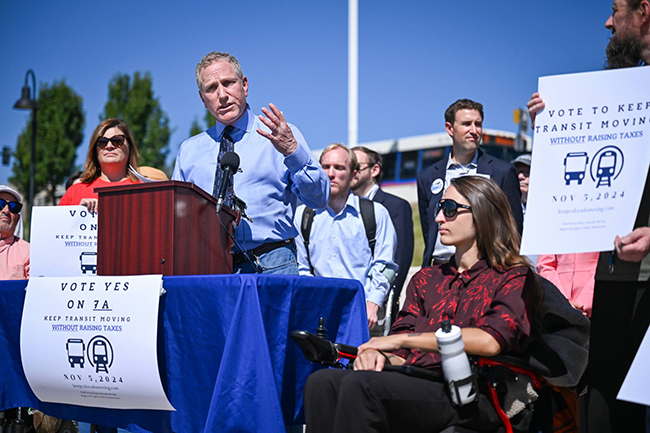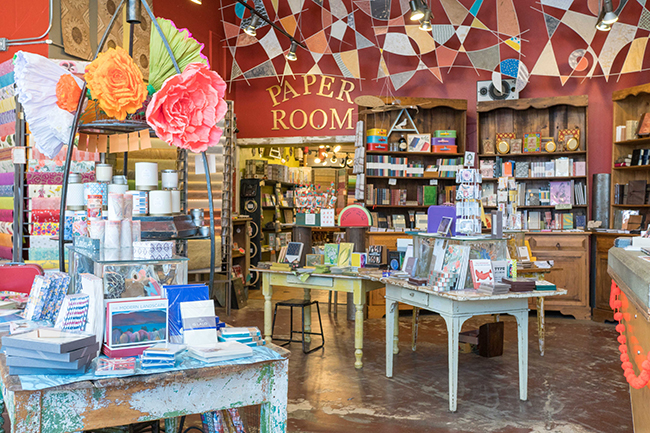Life Happens
01 Dec 2013
Life Happens
How a devastating flood taught one loner the power of community Essay and Photos by Lisa Marshall At 10 a.m. on Sept. 15, the fire chief in the quiet mountain hamlet I’ve called home for 18 years stood before a crowd of dazed residents huddled in the rain outside the station and spoke these unfathomable words: “Pinewood Springs is uninhabitable.”We had gone three days without power, heat, water or phones. The stretch of U.S. Highway 36 connecting us to Lyons nine miles to the east and Estes Park 11 miles to the west had been reduced to an impassable chasm in a dozen places. Churning, coffee-colored rivers flowed where our neighborhood roads once passed. Power lines dangled. Our local water system was in ruin.
Our community was an island, with no way in or out by car for the foreseeable future.
“Once the rain breaks, the choppers will start taking people out,” the chief told us. We should winterize our houses, double-bag our trash in hopes of keeping the bears away, and lock up. It could be months before we could return. “Those who don’t leave in the next day or so will be on their own.”
I clutched my 11-year-old’s hand and made an excruciating decision thousands of Coloradans had to make that surreal week. We would pack up our lives into one bag each, gather our pets, and leave the next day not knowing when life would be “normal” again.
Others—my husband included—made a different decision. To them, this was a call to action, a summons to practice the rugged individualism we mountain folks so often pride ourselves on. “Maybe you should just see how things play out,” he suggested. “People are working together. Things are happening really fast. I’m not going anywhere.”
As I walked home in the rain, paralyzed by uncertainty, they were gathering tools and crafting a plan.
Pinewood Springs is a speck on the map, a collection of several hundred dispersed houses inhabited by an eclectic mix. We are grizzled, aging hippies, clean-cut libertarian survivalists, yuppie commuters and none-of-the-aboves who—despite the wide range of political bumper stickers that adorn our mud-splattered vehicles—share a common quest for self-reliance. Walk our neighborhood and you hear roosters crowing and chainsaws buzzing.
Like many mountain dwellers, I like people, but only when I choose to be around them. I work from home and go days without leaving it. I smile as I jog past my neighbors, but I seldom stop to chat. I tell myself I am too busy. Really I am shy, and living nine miles from the closest stoplight has permitted me to remain that way.
But The Flood of 2013 changed me.
After the firehouse meeting, the sun broke through to reveal a bustle of activity. The next-door neighbor, Elise, came over to trade garden-fresh zucchini for tomatoes. Denise, from down the road, stopped in to use the half-bar of cell service we’d discovered we could get from one spot in my 14-year-old’s bedroom. Denise wept as she told her sister she was OK. To show her gratitude, she showed up with three bags of groceries to stock our barren cupboard, and a generator for my husband to use after we’d all flown out.
We walked down our washed-out road to the Colorado Cherry Company. With their stocked freezers thawing and fresh pies going to waste, the managers had generously opened their doors, offering up their limited propane for impromptu potlucks of homemade meatballs and quinoa casserole. Wine and beer flowed. A paper bag on the counter read “donations.” I milled around, exchanging embraces with people whose faces I’d seen for years but whose names I did not know.
A rumor was circulating: A group of guys on ATVs had scoped out an abandoned stagecoach route toward Lyons that—with some work and the blessing of landowners—could probably be passable to 4 wheel drives. If we waited a few days, at least we could drive our vehicles out. I was skeptical, and sticking with the plan.
The next morning, the military Chinook touched down next to the fire station, its spinning blades blasting us with a blistering wind as our line of weary refugees filed toward it. My two daughters marched ahead, relieved to be out of the chaos. But my stocky Rottweiler tugged frantically, wanting to stay behind with my husband. When I finally took a seat, my dog trembling in my lap, I felt the urge to ask the pilot to turn around.
Instead, I just cried.
Five days later, after renting a house a few blocks from my kids’ school in Estes Park, I decided to drive in as far as possible and hike home to convince my husband to come live with us (eventually, he obliged). My hands clutched the steering wheel as I headed east on the remaining but battered westbound lane of U.S. Highway 36 in the pouring rain. On the other side of the yellow line, slabs of black asphalt dangled like creased paper toward the retreating river.
When I arrived at the first football-field-length gash in the road, I was shocked at the progress I saw.
Using salvaged guardrail, donated two-by-fours, and hand tools, a resourceful band of locals had crafted a wide, flat walking/ATV path alongside the jumble of asphalt chunks. Residents filed in and out, some carrying in chicken feed or fuel, others carrying out winter clothes. Someone had even placed two potted flowering plants at the entrance—a cheerful welcome to our resilient village. The fabled 4-wheel-drive road to Lyons had also become reality. A neighbor named Vashek Berkah, who had fled Czechoslovakia in the 1980s, lived in a refugee camp and survived Hurricane Andrew in 1992, had helped to organize a crew to improve it, and spent three days working with the help of Hot Shot firefighters and volunteers. As a result, 200 motorists were able to drive their vehicles out. “We are not strangers to emergency,” Berkah told me later. “Life happens. You deal with it.”
As public utilities and government agencies struggled to reach us, the 75 or so residents who remained on Pinewood Island got an impressive head start toward cleaning up the mess. A makeshift security council patrolled the neighborhood to fend off looters. Others filled in ditches or cut up fallen trees. For those of us who, for work and family reasons, remained in exile, a local marketing whiz created a website and painstakingly updated it to keep us posted on what was happening at home.
Once I was finally able to return, in early November, I saw my community in a new light.
At a time when our elected officials in Washington had paralyzed our government with their bickering, my neighbors had put their differences aside and made miracles happen. And at a time when I was growing comfortably reclusive, they made me realize how much we all need each other.
My long runs are now pleasantly interrupted by roadside chats. I find myself gravitating to the cherry-pie shop just to be around people. And I feel a sense of connectedness I have never felt before.
I know I’m not the only one.
Lisa Marshall is a freelance journalist. Contact her at lisamarshall08@gmail.com.












